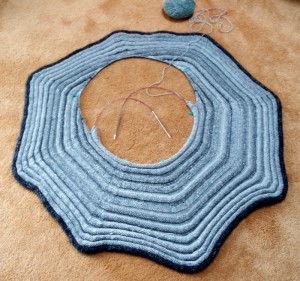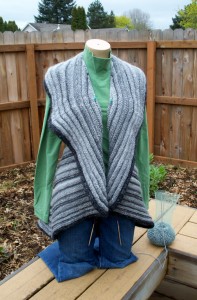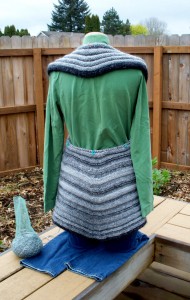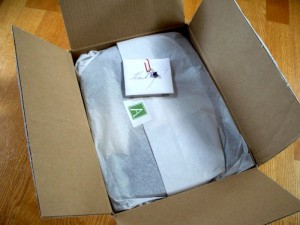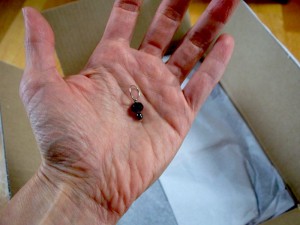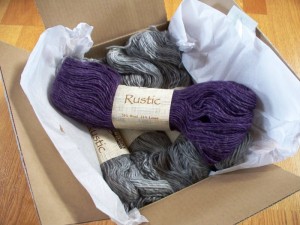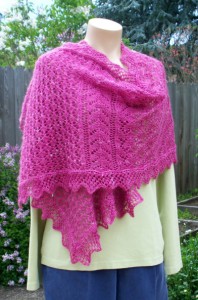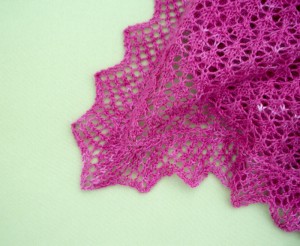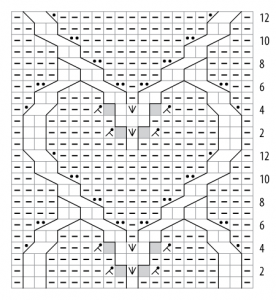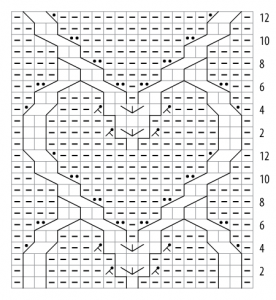- Stitches South was a blast, as usual. A highlight for me when two students who were in last year’s Charts Made Simple class said that instead of refusing to buy patterns with charts, they now refuse to buy patterns without charts—whoo hoo! Also, Yarn Barn of Kansas reported selling 90+ copies of Charts Made Simple—possibly a record for a single title at one show. At this rate, we’ll get the entire knitting community hooked on charts in no time. ;-)
- My Swirl jacket is progressing nicely. With luck, I’ll be able to wear it at The Loopy Ewe’s Spring Fling next week. I promise to take photos before seaming so I can show you how a Swirl is constructed.
- The Sock Summit class schedule is up! Surf on over and have a look at the awesome line-up.
Progress
By JC | April 10, 2011
Sock Camp was a great opportunity to make progress on my Swirl jacket. What once looked like brain coral is now clearly a giant octagon with a hole in the middle.
If you look closely, you can see an orange stitch marker clipped to the fabric, at the top of the opening. That’s where I switched from knitting in the round to knitting flat, decreasing as I went along to shape the opening. The live stitches that remain are all at the bottom of the opening.
But how will that octagon translate to a wearable garment? Jane the mannequin demonstrates:
The lower portion of the octagon wraps around the hips and under the arms, while the upper portion flips back to form the generous lapels and the back collar.
From this point, I’ll knit the live stitches—which currently run across the back waist—upwards to form the lower back bodice. Then I’ll cast on at the beginning of each row to increase rapidly. These added stitches will give me the length I need to knit dolman sleeves from cuff to cuff. After reaching the back neck, I’ll divide to create a neck opening and complete the sleeves by working downwards from the shoulder line. The only bit of finishing is a single seam that runs from the underside of one wrist to the underarm, across the front bodice (under the lapel) up a raglan line to the back neck, and down the opposite raglan line and sleeve to the other wrist.
Can you picture it? Maybe not now, but maybe after I post more in-progress photos. Suffice to say that I think Sandra McIver’s construction is ingenious, and that I really look forward to finishing (and wearing!) my Swirl.
Once upon a time, I managed a computer lab with a raised floor. Cables of all sorts ran under floor tiles that you could lift, revealing a hoard of dust bunnies in addition to the cables. Fortunately, I didn’t have to lift the tiles or deal with the dust bunnies very often. Unfortunately, these particular tiles were carpeted, and the edges of the carpets tended to fray and create tripping hazards. So, in the name of safety, every few months I would get down on my hands and knees and shear the carpet. For years, I thought that was one of the weirdest job responsibilities ever.
Until Sock Camp.
In theory, I go to Sock Camp to teach sock knitting. In practice, I get to learn and play, just like all the campers. My job responsibilities have included judging the results of scavenger hunts, coming up with Jeopardy questions, yarn bombing, and taking part in knitting competitions. Over the course of three Sock Camps, I have knit while holding a drill bit in one hand and a birthday candle in the other, while underwater, and—as of this past weekend—while hula hooping.
Kind of leaves the carpet shearing in the dust, doesn’t it?
Consider these mementos:
The bunny ears and the single-serving bottle of Kahlua (aka “liquid courage;” note the “DRINK ME” tag) were much-appreciated gifts from Cockeyed prior to my Talent Show performance. Remember, campers, the only rule of the Talent Show: what happens at Sock Camp, stays at Sock Camp. ’Nuff said.
The notebook came out of one of the afternoon craft sessions. Everyone had the option of decorating a graph-paper notebook with stamps, pretty papers, and pictures cut from magazines. I admit, I wasn’t inclined to take part at first. I didn’t know where to start. But then I figured it would be good to step outside my comfort zone and be creative without planning every last detail first. To keep the exercise from being completely open-ended, I gave myself a few simple rules: You must use photos of interesting textures. You may not cut the paper; you must tear it. You may not pre-plan the placement of the photos; if you dislike where a photo got glued, slap another on top of it. Wonder of wonders, despite the lack of planning I like the end results… especially after I decided at the last moment to break the first rule and slap a non-photo focal point in the center of the front cover.
The mini sock is courtesy of Anna Zilboorg. One afternoon, she taught her “Free Sole” sock architecture. In the toe-up version, you start by knitting the top of the toe and the instep. Then, as shown above in pink, you knit the bottom of the toe, the sole, the gussets, the heel turn, and the heel flap, attaching to the instep as you go. Finally you knit the leg. The idea is that if the sole or heel wears out, you can easily replace them without messing around with the rest of the sock. Overall, I think it’s pretty cool. I’m tempted to try it someday on full-size socks, holding a thin strand of mohair with the sock yarn while knitting the sole for extra cush and durability.
On top of all the fun and games, my new Socktastic Stitch Patterns class went pretty well. It was great to see students cut loose and come up with gorgeous new stitch patterns. Better yet was when they realized they liked playing around with charts, and they liked swatching. I can’t help but wonder what sock designs they’ll come up with.
All the talk of stitch patterns for socks inspired me too. Leafing through a catalog at breakfast this morning, I was struck by an idea. I charted it right away, and hope to find the time to swatch it soon.
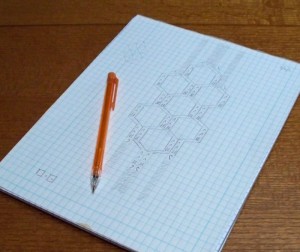
what will it look like when knitted up?
Teaching, learning, playing: I had a blast. Thanks, Tina. Thanks, Stephanie. Thanks for letting me be part of Sock Camp this year. Same time next year?
Pretty sure
By JC | March 30, 2011
Over the weekend, I finally had a chance to start my Swirl. You’ll notice I decided to go for the gray/black combo rather than the gray/purple.
At this point, it looks more like a chunk of brain coral than the start of a sweater, but I’m pysched: after checking a gazillion times, I’m sure that I cast on all 520 stitches correctly and that I joined into a round without twisting. Pretty sure, anyway.
This Swirl ought to serve as plenty of mindless knitting during downtime at Camp Jabberwonky—assuming there’s any downtime, of course. And assuming that I won’t feel too out of place working on a sweater rather than on socks. Of course, I’ve packed a few sock projects too, just to be on the safe side.
Look what came in the mail!
It’s from Abundant Yarns—and it came with a surprise.
It’s hard to tell in the photo—shoot, it’s hard to tell except in full sunlight—but the marker is a deep purple, to match the yarn. How sweet is that?
Actually, much as I love purple, most of the yarn is a gorgeous soft gray. It’s Cascade Rustic (I have an unexplainable fondness for wool/linen blends), and it’s destined to become a Swirl.
What’s a Swirl? You’ll find out soon enough, when Sandra McIver’s book knit, Swirl! comes out in June. Suffice to say that I’ve wanted one for three years, as I’ve watched Sandra’s book come together. Lucky me, I get to knit mine now, and wear it to the book’s launch at TNNA.
The original shown in the book is mostly a deep charcoal, with red highlights—absolutely stunning, but not “me.” Really, I’m not sold on the gray/purple combo either. At least it’s better than gray/green.
I knit the green swatch out of a skein that had been “curing” in my stash for years. It let me discover what needle size I’ll need to get gauge, but the green has too much yellow in it to play nicely with the gray.
I’m thinking I might get a skein of charcoal for the highlights. Then I’ll be able to wear the Swirl over whatever bright color I choose: a purple tank, a purple tee, a purple turtleneck… Sounds like a plan, eh?
Last spring I made a couple references in this blog to a stealth knitting project. That project was Abigail.
Designed for Amy Swenson’s Year of Lace club, I had fun knitting Abigail. Every chance I had last April, I knit a few more rows. The stitch patterns in the center of the shawl became so totally ingrained in my fingers that the knitting became meditative—I actually missed that section when it came time to knit the edging.
Then the edging was its own kind of fun: each completed edging point released another set of stitches from the needles, allowing that much more of the shawl to open up freely. Of course, the final effect wasn’t apparent until the shawl was blocked.
My agreement with Amy was that Abigail would remain exclusive to the Year of Lace club for one year, starting from that kit’s shipment last June. But yesterday a knitter asked when she could get her hands on the pattern. She figured Abigail would make a perfect wedding present.
Who were we to stand in the way of a wedding present? I asked, and Amy graciously released Abigail from the Year of Lace club. Now you can make Abigail’s acquaintance too, on Patternfish.
Over the weekend I received a curious email. Mary wrote to let me know she had posted a review of Charts Made Simple in Ravelry’s On The Other Hand forum. With Mary’s permission, here’s an excerpt:
I just had a chance to look at a new book that’s out and thought you all might be interested, as it has to do, somewhat, with lefty knitting.
The name of the book is “Charts Made Simple: Understanding Knitting Charts Visually,” by JC Briar.
Now we all know charts are very helpful for left handed (mirror) knitters and I was interested to see what Ms. Briar has to say about charts, never dreaming she might include tips for left handed knitters.
But she does!!!!
Though the book is written for “conventional knitters,” she specifically mentions lefty knitting (without judgment or rancor) as an “unconventional” knitting style (I love that!) and defines it — correctly, I might add. She then adds this in the preface under the section: “Charts are for every knitter”: “This book assumes you knit conventionally — but also includes tips for the unconventional knitter.”
She goes on to add: ”are you a true lefty knitter? … Charts are for you, too. Charts show which way each decrease is supposed to lean … And lefties can follow chart rows in the direction that naturally makes sense for them.”
We’re included! This is the first time I’ve ever seen this in a text on knitting. When I read this I just about dropped the book in amazement.
There is an even an entry in the index for lefty knitters and you can zoom directly to the mention of left handed knitting for specific chart issues! Her references to lefty knitting are well placed, she mentions our style without judgment or rancor. She accepts the fact that some knitters knit lefty and she is fully aware that charts are our friends!!!!!!
In other words, she gets it.
Mary’s review caught me off-guard. I mean, I was glad she liked the tips for lefty knitters. But, wow, she really liked them. She was surprised by them, even. And what’s this bit about “without judgment or rancor”? Do lefty knitters often face that much derision?
And then I remembered why I tried to make Charts Made Simple as inclusive as possible.
Years ago—long before I started teaching knitting—I was visiting a yarn shop and chatting with the owner when it came up in conversation that I happen to hold the yarn in my left hand. The shop owner was intrigued, and asked if she could watch me purl.
So we sat down, and I pulled out my knitting, and I did my usual “lazy purl.” The shop owner took one look at the resulting stitch—sitting on the needle with its right leg in back—and jumped out of her seat. “Your stitches are all twisted!” she exclaimed, literally turning her back on me and refusing to watch or listen further.
As you may have guessed, I was a bit put off. More than a bit: I quit visiting her shop.
I can deal with typical knitting instructions. By convention, they assume the knitter always wraps the yarn around the right needle such that the new stitch sits with its right leg in front of the right needle. These conventions suit most knitters, and permit succinct instructions.
I understand what conventional instructions are trying to say, the end goal they’re trying to express. And in my classes I can counsel students into understanding how to interpret those instructions—even if they wrap the yarn “the other way” when they purl, or they knit lefty and create new stitches on their left needle.
What I can’t quite deal with is the notion of a “right” way to knit. A single “right” way implies a multitude of “wrong” ways, and I just don’t buy that. There is no wrong way to knit. It’s all a question of what works for a given knitter: if you enjoy the process and like what you create, then it’s all good.
So, Mary… you shouldn’t have been surprised. I’m all for including all kinds of knitters. And thanks again for the generous review. 🙂
Franklin Habit wrote a too-true post last week about the disorientation that comes with travel, and needing to remind himself where he is and what he needs to do.
For me, the disorientation comes after I return home. “Re-entry” can take days. For instance, I got back from Stitches West late on Sunday. Monday and Tuesday were a blur of email and errands. Yesterday had a hint of normalcy to it. Today is Thursday, and finally I’m starting to feel productive again.
But let’s backtrack for a moment, shall we?
Stitches was, as usual, awesome. Even with 200+ more students than ever before, classes ran smoothly. The Fashion Show was a smashing success with over 120 garments—though I only saw a fraction of them while helping backstage. And rumor has it that over 10,000 people attended the Market!
That huge crowd in the Market could help explain why Charts Made Simple sold out by Friday afternoon. That’s right, with two days left to go, no books were available from any Market vendor. Whew! We’ll have to stock up better before Stitches South, won’t we?
Speaking of stocking up… once again, Amazon lists Charts Made Simple as out of stock. sigh. In theory, Amazon keeps tabs on how well a book is selling, and purchases enough to keep at least a few copies in stock at all times. In practice… well, not so much. Rest assured, though, that “out of stock” does not mean “out of print,” and that orders placed with Amazon will be filled as soon as possible. Other vendors—such as your local yarn shop—are an option too.
In other news, Blue Moon Fiber Arts announced Camp Jabberwonky, this year’s Sock Camp. I’m thrilled to be going back to Camp, and especially thrilled to be teaching a new class, Socktastic Stitch Patterns. It’s going to be a blast! The only bummer, of course, is that I won’t be able to take any of the other classes. Maybe someday I’ll get a chance to dye at Tina’s elbow.
Further afield, this June I’ll be teaching at Knitters Connection in Columbus, OH. Eight classes in four days… oh, yeah, re-entry is going to be tough after that one, too.
Okay, that’s enough announcements for one blog post, don’t you think?
Oh, wait, sorry, I just remembered one more: after resisting for years, I was strong-armed into joining Facebook last week. I still haven’t got it quite figured out. In theory, I have things set up such that blog posts like this one will appear on my Facebook page. In practice… we’ll see.
Clara Parkes wrote the coolest review of Charts Made Simple yesterday. My favorite quote: “To resist charts in knitting is like resisting the purl stitch.” Too true!
By the way, for all of you looking for Charts Made Simple on Amazon: It may be listed as out of stock at the moment, but that won’t last for long. Hundreds of books are winging their way to Amazon’s warehouses, and will be there as soon as UPS can make it happen.
Some of you may have noticed that, of late, the actual knitting content on this blog has been… well… sparse. Practically absent.
Partly it’s because my attention has been elsewhere, on a large cough book cough project. Partly it’s because my knitting mojo has been missing: I just haven’t felt like knitting, so I haven’t had much to show. (It happens, sometimes. Don’t worry; my mojo will find its way back eventually. It always does.)
Still, this is a knitting blog, and knitting content of some sort is in order. So lemme share a little pet peeve with you. It’s something I’ve kept under my hat for a long time, in the name of being polite and tolerant and all that piffle.
Chart symbols that aren’t as wide as the number of stitches they represent—like ![]() for a centered double increase, or
for a centered double increase, or ![]() for knit into front and back of next stitch—irk the snot out of me.
for knit into front and back of next stitch—irk the snot out of me.
Whew! It feels good to say that out in the open. 🙂
Here’s why: Most chart symbols are as wide as the number of stitches that end up on your right needle when you have completed whatever that symbol is telling you to do. ![]() ,
, ![]() , and
, and ![]() are all one square wide because working any of them—p1, k2tog, or yo—results in one stitch on your right needle, even though you need one stitch to p1, two to k2tog, and none to yo. Likewise,
are all one square wide because working any of them—p1, k2tog, or yo—results in one stitch on your right needle, even though you need one stitch to p1, two to k2tog, and none to yo. Likewise, ![]() is four squares wide because working a two-over-two cable cross results in four stitches. What matters is the number of stitches you end up with, not the number you start with. Nearly all chart symbols work this way.
is four squares wide because working a two-over-two cable cross results in four stitches. What matters is the number of stitches you end up with, not the number you start with. Nearly all chart symbols work this way.
(Side note: I know of only one book—that shall remain nameless; I don’t want to add to its notoriety—where all the symbols work the opposite way, each as wide as the number of stitches you need to work the symbol. K2tog are two squares wide; yo are dots between chart squares. Take my word for it—those charts are icky!)
Mixing standard, sensible, as-wide-as-the-stitches-they-produce symbols with symbols like ![]() and
and ![]() leads to unnecessary funkiness in charts. Take a gander at this example:
leads to unnecessary funkiness in charts. Take a gander at this example:
You have heart-shaped cables, stacked in a column. Each heart begins with some increases geared to make the heart’s pointy end appear suddenly in sharp relief against the reverse stockinette background. Matching decreases keep the stitch count constant. Yet because ![]() isn’t as wide as it should be, placeholder “no stitch” symbols have to be thrown in to fill in the gaps.
isn’t as wide as it should be, placeholder “no stitch” symbols have to be thrown in to fill in the gaps.
Don’t get me wrong. I’m a big fan of “no stitch” symbols when they’re used properly: to indicate changes in stitch count, or to allow elements of a stitch pattern to line up vertically in the chart as they will in the finished fabric.
But the “no stitch” symbols in the example above are completely unnecessary. And they’re confusing: glancing at the chart, you’d think the stitch count changes from row to row—but it doesn’t.
What’s the alternative? Consistently using symbols that are as wide as their resulting stitch count, such as ![]() for centered double increases and
for centered double increases and ![]() for knit into front and back. Consider:
for knit into front and back. Consider:
Voilà! With ![]() for centered double increases, the placeholder “no stitch” symbols can go away.
for centered double increases, the placeholder “no stitch” symbols can go away.
So? Have I convinced you to abandon ![]() and
and ![]() in favor of
in favor of ![]() and
and ![]() ? If not, I can rant further.
? If not, I can rant further.



